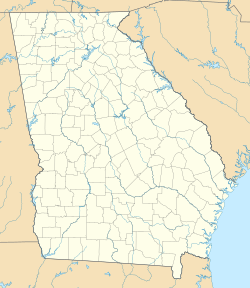North Highlands Dam facts for kids
Quick facts for kids North Highlands Dam |
|
|---|---|

North Highlands Dam and Power Plant 1920
|
|
| Location | Columbus, Georgia / Phenix City, Alabama |
| Coordinates | 32°29′58″N 84°59′46″W / 32.4995°N 84.996°W |
| Primary inflows | Chattahoochee River |
| Primary outflows | Chattahoochee River |
| Basin countries | United States |
| Surface elevation | 269 ft (82 m) |
The North Highlands Dam is a big structure built across the Chattahoochee River. You can find it near the city of Columbus, Georgia in the United States. It's about four miles north of downtown Columbus. This dam was built way back in 1899. Its main job was to create power for a large factory called the Bibb City Mill. It was one of the very first big dams built in the southern part of the United States. The Columbus Electric and Power Company first owned the dam. Later, in 1930, Georgia Power bought it.
History of the Dam
Columbus, Georgia is located on something called the fall line. This is a natural point where the land changes elevation. Because of this, the Chattahoochee River has fast-moving rapids here. Long ago, this fall line was a key spot for river travelers. They would carry their boats and goods around the rapids. It was also a perfect place to build dams and mills. These structures could use the power of the falling water.
The Chattahoochee River was very important when Columbus was founded in 1828. The city built three dams to use the river's power. As Columbus grew, the North Highlands Dam was built. It was made to power the Bibb City Mill. Around the year 1900, this mill had more spindles (parts of machines that spin thread) than any other mill in the U.S.
Later, the dam's power also helped grind corn and wheat. It also sawed lumber for the growing community. A big flood in 1901 almost destroyed the dam. It was rebuilt and improved two years later.
Power Generation
After the rebuild, two separate powerhouses were constructed. One powerhouse made about 5,000 kilowatts of electricity for general use. The other powerhouse sent power directly to the Bibb City Mill. It used a special system called a rope drive. This rope drive system was used until 1954.
The dam got a major upgrade in 1963. The old powerhouses were replaced with a new one. This new powerhouse had four units. It could produce a lot more power, about 29,600 kilowatts.
Bibb Pond
The North Highlands Dam creates a body of water called Bibb Pond. This pond covers 131 acres of water. It has about three miles of shoreline. The water level is about 269 feet above mean sea level. Today, Georgia Power owns the dam. It is fully automated and controlled from a place called Bartletts Ferry.
Water Flow and Discharge
The amount of water flowing out of the dam is called discharge. From 1929 to 1960, the average discharge was about 6,286 cubic feet per second. This means 6,286 cubic feet of water flowed out every second. The amount of water flowing out changes a lot during the year. This depends on how much rain falls in the Chattahoochee River area. The river system that feeds the dam covers about 4,670 square miles.
In 1960, the most water flowed out in April, at 59,100 cubic feet per second. The least water flowed out in October, at 1,220 cubic feet per second. The highest amount of water ever recorded flowing out was on March 16, 1929. On that day, 198,000 cubic feet per second flowed out.


